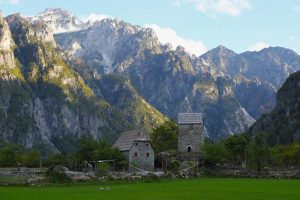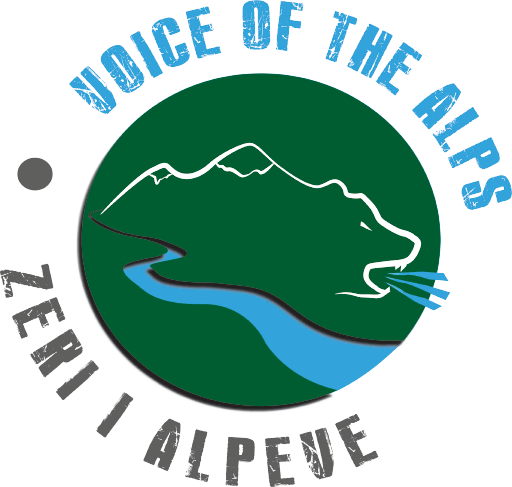
Day 1: Airport – Shkoder (1.5 hours driving time)
The North of Albania has
- an unspoilt nature
- a unique landscape
- offers the opportunity to meet interesting and unusual people
- offers the opportunity to experience an interesting ancient culture
The City of Shkoder
“Rome of the Balkans”
The city of Shkoder is situated at Skutari Lake, the greatest lake on the Balkan Peninsula.
After the division of the Roman Empire in 395 AC Northern Albania became part of Western Rome where the Roman Catholic Church has always had an important influence.
The visitor who doesn’t mind some kind of “regulated chaos” and who likes dynamic and spontaneous activity and zest for life will have the opportunity to meet interesting and unusual people and have unforgettable experiences in the enchanting city of Shkoder.
Since more than hundred years classical as well as modern pays are performed in the Migjeni-Theater in the center of the city.
Rozafa Castle is situated on the rock at the entrance of the city. It was the heart of the Illyrian Culture where the last Illyrian King, Great Of Gent , was made prisoner by the Romans in 168 BC.
Day 2: Shkoder – Theth (4 hours driving time)
After early breakfast we drive towards Lake Shkoder in Koplik and then turn to the right through lavender fields before starting to climb through stunning limestone mountains . Once the road reaches Boga village, we twist and turn past breathtaking scenery and arrive at the mountain village of Theth in the middle of the Thethi National Park, passing through the neck of Thore. After unloading our discovery equipment we will take a familiarization tour of the village lasting between 3-5 hours, staring with the church of Thethi originally built in 1892, rebuilt and reroofed in 2005. Roughly opposite the church across a field is the “Kulla e ngujimit” or “Lock-in Tower” which can be seen only from outside, testimony to a system of rigid and cruel codes to the modern visitors, but which has regulated an isolated lifestyle in these far away mountains, for centuries. Another inaccessible monument inside, the old water-mill, situated just below the tower was used by the locals to grind corn. Then we walk up the mill, following a path that leads to the waterfall Grunas (25-30 minute walk) until we see the magnificent waterfall Grunas to the left in a deep pool, and crystal clear water of it is so cold that any thoughts of a swim, after the visit to the waterfall, you will receive walking path to go down to tearing Gerlës Bridge, with a stunning canyon of Thethit which is located below the bridge with geries 2 and 30 m above the canyon. , Visit the canyon will probably be moved into the village and mikorhidrocentralit near the wooden bridge that connects the village neighborhoods (Gjecajve bridge). Overnight at local guest house in the village Theth
Day 3: Theth – Valbona (no driving)
Walk to Valbona through some of the wildest scenery into the Tropoje District, known as the home of Albanian folk culture. We walk for about 8 hours through forests and alpine pastures and from Valbona pass (1950m), we take a few moments to enjoy the spectacular views down Valbona and Theth Valley. As we pass Valbona River, some beautiful waterfalls and the quaint village of Rragam, our luggage is transported by horse to the next guesthouse.
The National Park of Valbona valley is situated 30 kilometres north-west of the town of Bajram Curri. It has a surface of about 8,000 hectares. This park is considered a miracle of the Albanian Alps offering an amazing diversity in shapes, forms, colours, flora and fauna. The forests and pastures, the rivers and alpine lakes, the miscellaneous flowers, the characteristic houses and the hospitality of the inhabitants altogether create a unique place which can be explored on different levels. Our journey of today will provide you with plenty of material to satisfy your senses and brag about to friends and family. During the communism period , only members of the government, locals and authorized forest technicians and a handful of important visitors from foreign countries with which Albania had political relations – such as Russia, Bulgaria, Poland – were allowed to enter this region needed a special authorization from the government.
Luckily the beauty of Valbona is nowadays available for all to explore and respect. Overnight at local guest house.
Day 4: Valbona (no driving)
Our route today takes us through beech and pine forests down Rosi Peak and leads us onto the “White Circle”, where we enjoy panoramic views across the peaks and valleys of the Albanian Alps (approx. 6 hours walk). Valbona Valley is part of Tropoja district which in turn falls under the Albanian Alps with numerous mountains reaching a height of above 2,000 meters. There are mountainous massifs like the Eastern Block of Jezerca (its peak is 2,694 meters high). The Block of Maja e Hekurave (2,561 m) is distinguished for its asymmetric slopes and the peak which has a conical form. Shkelzeni peak (2,407 m) lies among the tectonic formations and has a pyramidal shape. The ridge is covered with forests of oaks, beech wood and some conifers up to the carbonic slopes whereas on the top there are some alpine pastures. Overnight at local guest house.
Day 5:
Valbona- Fireza – Koman Lake – Shkodra – Shkodra Lake – Velipoja.
Roughly two hours, the trip offers spectacular, scenic views. Lacking the sight of cities and villages, only solitary houses can be seen in the middle of vast mountains. There are two ferries that run daily and allow locals and tourist alike to share the same experience of the
lake and neighboring mountains. One ferry holds cars and is a larger barge. The other is a boat that is mainly used by locals being dropped off into their remote villages.
It’s an amazing sight of sheer cliffs and rolling mountains on the narrow, twisting lake with clear water. It is an unusual sight to see residents make something out of the difficult terrain, supporting their livelihood far, far away from schools, hospitals and other people. Throughout the trip, you can see lonely houses on top of the hills, or nearer to the lake, far from the previous and the next house, Overnight at Local Guest Houses in Velipoja.
For more information, please contact us at: [email protected]
